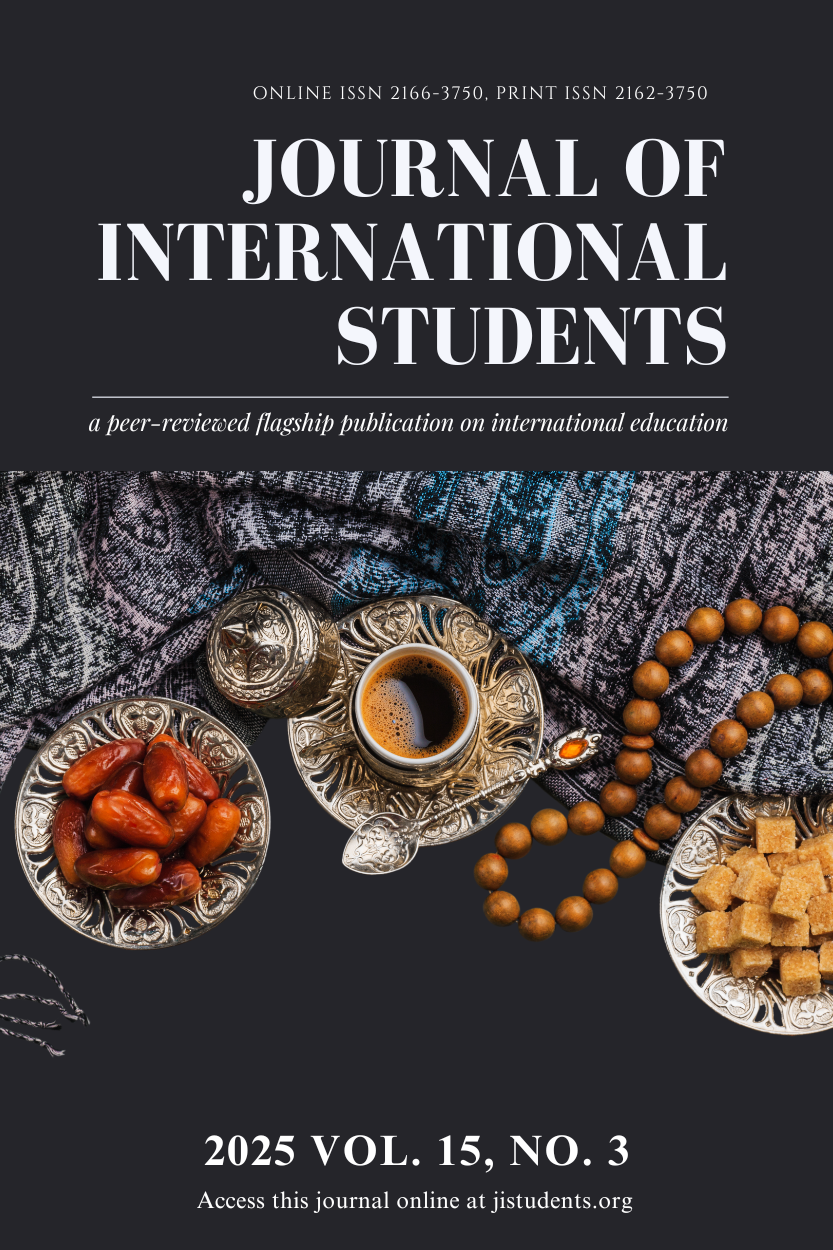Effect of a training program on the psychological, cultural, and social alienation experienced by foreign students in Jordan
DOI:
https://doi.org/10.32674/yw8hgx97Keywords:
Alienation, Foreign Students, Educational Program, Psychological Alienation, Cultural Alienation, Social Alienation.Abstract
In this study, we examined the effectiveness of an educational training program in reducing psychological, cultural, and social alienation among international students. A total of 73 undergraduate students from diverse nationalities participated in the study. The training program comprised six seminars delivered over three weeks, with two lectures conducted weekly. Topics covered included Jordanian culture and traditions, academic procedures, students' rights and responsibilities, support services, local geography, financial management, and safety. Pre- and post-program assessments utilized validated tools to measure levels of alienation. Findings revealed a significant reduction in social and cultural alienation, underscoring the program's success in fostering social connections and cultural understanding. However, an unexpected increase in psychological alienation was noted, highlighting the need to address psychological challenges more effectively. These results emphasize the importance of comprehensive orientation programs tailored to mitigate all dimensions of alienation, ultimately enhancing the overall well-being of international students.
References
Alasmari, A. A. (2023). Challenges and social adaptation of international students in Saudi Arabia. Heliyon, 9(5), e16283–e16283. https://doi.org/10.1016/j.heliyon.2023.e16283. DOI: https://doi.org/10.1016/j.heliyon.2023.e16283
Al-Ahwani, H. H. (1988). A Study of Some Psychological Aspects of Alienation Among University Youth and Their Relation to the Type of Higher Education. Master's Thesis, Faculty of Education, Al-Azhar University.
Al-Badarneh, M.; Al-Farram, A.; Bani Yassin, B.; & Khasawneh, A. (2023) The Level of Psychological Alienation and its Relationship to the Prevalence of Irrational Thoughts among a Sample of Syrian Students in Jordan in Light of Gender Differences, Journal of Education, 20(2): 140-169.
Al-Habies, F. A. M., Tarawneh, H., Al Dalaeen, I. D. A. N., Tarawneh, H. H., Dawaghreh, S. A., Jawarneh, A. I. A., … Alorani, O. I. H. (2024). The impact of Cognitive Behavioral Therapy (CBT) program on anxiety disorder and memory recall. Periodicals of Engineering and Natural Sciences, 12(1), 183–190. DOI: https://doi.org/10.21533/pen.v12.i1.29
Al-Kubaisi, S. A. (2002). Social Alienation Scale. Journal of Al-Qadisiyah University for Humanities, 3(22), 614-630.
Al-Moussawi, H. (1997). Psychological Alienation in Segments of Kuwaiti Society: An Analytical Study. Journal of Educational and Psychological Research, College of Education, Minia University, 10(4), 52-58.
Andrade, M. S. (2006). International students in English-speaking universities: Adjustment factors. Journal of Research in International Education, 5(2), 131-154. https://doi.org/10.1177/1475240906065589 DOI: https://doi.org/10.1177/1475240906065589
Brown, L., & Holloway, I. (2008). The adjustment journey of international postgraduate students at an English university: An ethnographic study. Journal of Research in International Education, 7(2), 232-249. https://doi.org/10.1177/1475240908091306 DOI: https://doi.org/10.1177/1475240908091306
Corney, T., du Plessis, K., Woods, B., Lou, C., Dewhurst, A., & Mawren, D. (2024). ‘If you are feeling alone and you are not feeling safe, it impacts everything’: a mixed-methods exploration of international students’ accommodation, subjective wellbeing and mental health help-seeking. BMC public health, 24(1), 1262. DOI: https://doi.org/10.1186/s12889-024-18691-8
Glass, C. R., Wongtrirat, R., & Buus, S. (2015). International student engagement: Strategies for creating inclusive, connected, and purposeful campus environments. Stylus Publishing.
Hendrickson, B., Rosen, D., & Aune, R. K. (2011). An analysis of friendship networks, social connectedness, homesickness, and satisfaction levels of international students. International Journal of Intercultural Relations, 35(3), 281-295. https://doi.org/10.1016/j.ijintrel.2010.08.001 DOI: https://doi.org/10.1016/j.ijintrel.2010.08.001
Li, Y., Wang, W., & Xiao, L. (2014). Psychological well-being of international students in the United States: A study of Chinese students’ adaptation. Journal of International Students, 4(4), 349-362. https://doi.org/10.32674/jis.v4i4.460 DOI: https://doi.org/10.32674/jis.v4i4.450
Lin, C., & Scherz, S. (2018). A qualitative phenomenological study of emotional and cultural intelligence of international students in the United States. Journal of International Students, 8(4), 1527–1545. https://doi.org/10.32674/jis.v8i4.128
Misra, R., Crist, M., & Burant, C. J. (2003). Relationships among life stress, social support, academic stressors, and reactions to stressors of international students in the United States. International Journal of Stress Management, 10(2), 137-157. https://doi.org/10.1037/1072-5245.10.2.137 DOI: https://doi.org/10.1037/1072-5245.10.2.137
Poyrazli, S., & Grahame, K. M. (2007). Barriers to adjustment: Needs of international students within a semi-urban campus community. Journal of Instructional Psychology, 34(1), 28-45.
Russell, J., Rosenthal, D., & Thomson, G. (2010). The international student experience: Three styles of adaptation. Higher Education, 60(2), 235-249. https://doi.org/10.1007/s10734-009-9297-7 DOI: https://doi.org/10.1007/s10734-009-9297-7
Sawir, E., Marginson, S., Deumert, A., Nyland, C., & Ramia, G. (2008). Loneliness and international students: An Australian study. Journal of Studies in International Education, 12(2), 148-180. https://doi.org/10.1177/1028315307299699 DOI: https://doi.org/10.1177/1028315307299699
Selvadurai, R. (1998). Problems faced by international students in American colleges and universities. Community Review, 16(1–2), 153–158.
Tinto, V. (1993). Leaving college: Rethinking the causes and cures of student attrition (2nd ed.). University of Chicago Press. DOI: https://doi.org/10.7208/chicago/9780226922461.001.0001
Trice, A. G. (2004). Mixing it up: International graduate students' social interactions with American students. Journal of College Student Development, 45(6), 671-687. https://doi.org/10.1353/csd.2004.0074 DOI: https://doi.org/10.1353/csd.2004.0074
Wang, K. T., Heppner, P. P., Fu, C. C., Zhao, R., & Li, F. (2012). Profiles of acculturative adjustment patterns among Chinese international students. Journal of Counseling Psychology, 59(3), 424–436. https://doi.org/10.1037/a0028532 DOI: https://doi.org/10.1037/a0028532
Ward, C. (2001). The impact of international students on domestic students and host institutions: A literature review. Ministry of Education. https://www.educationcounts.govt.nz/publications/international/the_impact_of_international_students_on_domestic_students_and_host_institutions
Ward, C., Bochner, S., & Furnham, A. (2001). The psychology of culture shock (2nd ed.). Routledge.
Yeh, C. J., & Inose, M. (2003). International students reported English fluency, social support satisfaction, and social connectedness as predictors of acculturative stress. Counseling Psychology Quarterly, 16(1), 15–28. https://doi.org/10.1080/0951507031000114058 DOI: https://doi.org/10.1080/0951507031000114058
Zhang, J., & Goodson, P. (2018). Cross-cultural adaptation of international college students in the United States. Journal of International Students, 8(1), 901–925. https://doi.org/10.32674/jis.v8i1.62 DOI: https://doi.org/10.32674/jis.v8i2.116
Downloads
Published
Issue
Section
Categories
License
Copyright (c) 2025 Journal of International Students

This work is licensed under a Creative Commons Attribution-NonCommercial-NoDerivatives 4.0 International License.
All published articles are licensed under a Creative Commons Attribution-NonCommercial-NoDerivs 4.0 Unported License.















